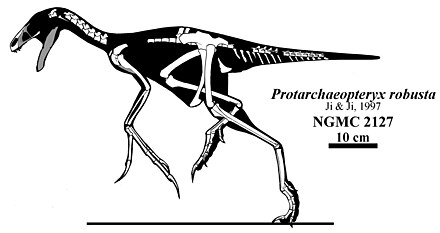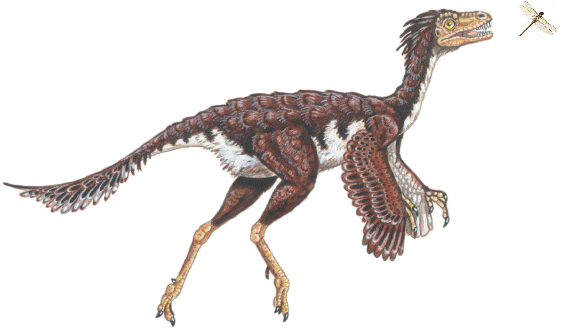brother Paul
Member
- Apr 10, 2014
- 1,421
- 221
In Richard Monastersky’s “A Clawed Wonder Unearthed in Mongolia,” Science News, 143:245, April 17. (1993) one fossilized bird from a much earlier time than Archaeopteryx was found in Mongolia and yes it had claws and teeth, but it was still just a bird. In addition some modern birds also have a claw or claws on their wing but they are just birds. And what about Protoavis found in Texas? It is a bird with teeth from millions and millions of years before Arche…is Arche really just a transitional form that shows a certain kind of reptile evolved from birds? Researcher and evolutionist Dr. Sankar Chatterjee, the Curator of Paleontology at Texas Tech University, recorded that Protoavis has 23 features that are fundamentally bird-like, as are the forelimbs, the shoulders, and the hip girdle along with “a flexible neck, large brain, binocular vision, and, crucially, portals running from the rear of the skull to the eye socket—a feature seen in modern birds but not dinosaurs.” Anderson, Alan (1991), “
See Early Bird Threatens Archaeopteryx’s Perch,” Science, 253:35, July 5. It certainly does threaten it because it means Avians existed 210,000,000 years ago. But who’s counting?
Feduccia and *H.B. Tordoff, in Science, 203 (1979), p. 1020, tell us “in Archaeopteryx, it is to be noted, the feathers differ in no way from the most perfectly developed feathers known to us." Also Archaeopteryx is said to have thin, hollow wing and leg bones such as a bird has. In fact P. Moody in, Introduction to Evolution (1970), pp. 196-197, points out that “other extinct birds had teeth, and every other category of vertebrates contains some organisms with teeth, and some without (amphibians, reptiles, extinct birds, mammals, etc.)." And A.S. Romer, who actually saw the fossils in his Notes and Comments on Vertebrate Paleontology (1968), p. 144, reveals that despite the common media presentations "This Jurassic bird stands in splendid isolation; we know no more of its presumed thecodont ancestry nor of its relation to later `proper' birds than before."
Conclusion? "It is obvious that we must now look for the ancestors of flying birds in a period of time much older than that in which Archaeopteryx lived." See J. Ostrom, Science News, 112 (1977), p. 198.
Birds obviously existed long before Archaeopteryx (evidence provided)! So if Archy IS a "transitional form" then this alleged dinosaur (terrible or giant LIZARD) had to have evolved from birds, not the other way around (this does not speak to other extant reptiles). Similarity in bone structure (though the quality of bone is far different from their alleged reptilian counterparts) does not guarantee either CAME FROM the other (it is an assumption based conclusion made only by those who are interpreting the evidence from the theory and not forming the theory based on the evidence)
As David Pilbeam, curator of paleoanthropology at the Peabody Museum of Archaeology and Ethnology, Harvard University, points out in his article in Pro-Evolution, Vol. 14, p.127, “...in my own subject of Paleo-anthropology the “theory” heavily influenced by implicit ideas, almost always dominates data...ideas that are totally unrelated to actual fossils have dominated theory building, which in turn strongly influences the way fossils are interpreted ”.
Feduccia and *H.B. Tordoff, in Science, 203 (1979), p. 1020, tell us “in Archaeopteryx, it is to be noted, the feathers differ in no way from the most perfectly developed feathers known to us." Also Archaeopteryx is said to have thin, hollow wing and leg bones such as a bird has. In fact P. Moody in, Introduction to Evolution (1970), pp. 196-197, points out that “other extinct birds had teeth, and every other category of vertebrates contains some organisms with teeth, and some without (amphibians, reptiles, extinct birds, mammals, etc.)." And A.S. Romer, who actually saw the fossils in his Notes and Comments on Vertebrate Paleontology (1968), p. 144, reveals that despite the common media presentations "This Jurassic bird stands in splendid isolation; we know no more of its presumed thecodont ancestry nor of its relation to later `proper' birds than before."
See Early Bird Threatens Archaeopteryx’s Perch,” Science, 253:35, July 5. It certainly does threaten it because it means Avians existed 210,000,000 years ago. But who’s counting?
Feduccia and *H.B. Tordoff, in Science, 203 (1979), p. 1020, tell us “in Archaeopteryx, it is to be noted, the feathers differ in no way from the most perfectly developed feathers known to us." Also Archaeopteryx is said to have thin, hollow wing and leg bones such as a bird has. In fact P. Moody in, Introduction to Evolution (1970), pp. 196-197, points out that “other extinct birds had teeth, and every other category of vertebrates contains some organisms with teeth, and some without (amphibians, reptiles, extinct birds, mammals, etc.)." And A.S. Romer, who actually saw the fossils in his Notes and Comments on Vertebrate Paleontology (1968), p. 144, reveals that despite the common media presentations "This Jurassic bird stands in splendid isolation; we know no more of its presumed thecodont ancestry nor of its relation to later `proper' birds than before."
Conclusion? "It is obvious that we must now look for the ancestors of flying birds in a period of time much older than that in which Archaeopteryx lived." See J. Ostrom, Science News, 112 (1977), p. 198.
Birds obviously existed long before Archaeopteryx (evidence provided)! So if Archy IS a "transitional form" then this alleged dinosaur (terrible or giant LIZARD) had to have evolved from birds, not the other way around (this does not speak to other extant reptiles). Similarity in bone structure (though the quality of bone is far different from their alleged reptilian counterparts) does not guarantee either CAME FROM the other (it is an assumption based conclusion made only by those who are interpreting the evidence from the theory and not forming the theory based on the evidence)
As David Pilbeam, curator of paleoanthropology at the Peabody Museum of Archaeology and Ethnology, Harvard University, points out in his article in Pro-Evolution, Vol. 14, p.127, “...in my own subject of Paleo-anthropology the “theory” heavily influenced by implicit ideas, almost always dominates data...ideas that are totally unrelated to actual fossils have dominated theory building, which in turn strongly influences the way fossils are interpreted ”.
Feduccia and *H.B. Tordoff, in Science, 203 (1979), p. 1020, tell us “in Archaeopteryx, it is to be noted, the feathers differ in no way from the most perfectly developed feathers known to us." Also Archaeopteryx is said to have thin, hollow wing and leg bones such as a bird has. In fact P. Moody in, Introduction to Evolution (1970), pp. 196-197, points out that “other extinct birds had teeth, and every other category of vertebrates contains some organisms with teeth, and some without (amphibians, reptiles, extinct birds, mammals, etc.)." And A.S. Romer, who actually saw the fossils in his Notes and Comments on Vertebrate Paleontology (1968), p. 144, reveals that despite the common media presentations "This Jurassic bird stands in splendid isolation; we know no more of its presumed thecodont ancestry nor of its relation to later `proper' birds than before."
Last edited:









